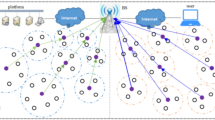Abstract
Delay tolerant networks are among mobile ad hoc networks. There is not a complete and connected route between the source and destination in these networks due to the dispersion of the nodes and inconsistency of the links between the nodes every moment. Therefore, store-carry and forward patterns is used to send the data. If the source node encounters the destination node, it delivers the message to the destination or else it waits for an appropriate opportunity. The previous algorithms such as Fuzzy Spray, APRP, AFRON, AFSn, and Enhanced Fuzzy logic-based Spray and wait have used fuzzy logic to manage buffer. It seems that using fuzzy logic to determine the relay node can increase the efficacy of these networks. In this paper to determine the relay node we have used fuzzy logic. The fuzzy system inputs are buffer capacity parameters, remaining energy, and the number of node encountering. The output of fuzzy system can be one of the states of do nothing (don’t send), spray relay, direct transmission and carrier node. The simulation results showed that the proposed method has had improved the similar methods regarding the hop count and the delivery ratio.









Similar content being viewed by others
References
Umaparvathi, M., Bhalaji, N., Prasanna, S. J., & Parthiban, N. (2016). Analysis of creido enhanced chord overlay protocol under different movement models in delay tolerant networks. Wireless Personal Communications, 90(2), 985–1001.
Puri, P., & Singh, M. P. (2013). A survey paper on routing in delay tolerant networks. In International conference on paper presented at the information systems and computer networks (ISCON), 2013.
Daly, E. M., & Haahr, M. (2007). Social network analysis for routing in disconnected delay-tolerant manets. In Paper presented at the Proceedings of the 8th ACM international symposium on mobile ad hoc networking and computing.
Benamar, N., Singh, K. D., Benamar, M., El Ouadghiri, D., & Bonnin, J.-M. (2014). Routing protocols in vehicular delay tolerant networks: A comprehensive survey. Computer Communications, 48, 141–158.
De Rango, F., Tropea, M., Laratta, G. B., & Marano, S. (2008). Hop-by-hop local flow control over interplanetary networks based on DTN architecture. In International conference on communications paper presented at the 2008 IEEE.
Ayub, Q., Ngadi, M. A., Rashid, S., Ahmedy, I., Sharif, J. M., & Zahid, M. S. M. (2017). Probabilistic and replication based locking routing protocol for delay tolerant network. Wireless Personal Communications, 97(2), 3239–3259.
Xia, M., Wang, Q., Wang, Q., Cao, C., Wang, L., & Guo, H. (2017). Two-level community-based routing in delay tolerant networks. Wireless Personal Communications, 96(4), 5687–5704.
Khalid, O., Rais, R. N. B., & Madani, S. A. (2017). Benchmarking and modeling of routing protocols for delay tolerant networks. Wireless Personal Communications, 94(3), 859–888.
Hui, P., Chaintreau, A., Scott, J., Gass, R., Crowcroft, J., & Diot, C. (2005). Pocket switched networks and human mobility in conference environments. In Paper presented at the Proceedings of the 2005 ACM SIGCOMM workshop on delay-tolerant networking.
Jain, S., Chawla, M., Soares, V. N., & Rodrigues, J. J. (2016). Enhanced fuzzy logic-based spray and wait routing protocol for delay tolerant networks. International Journal of Communication Systems, 29(12), 1820–1843.
Mathurapoj, A., Pornavalai, C., & Chakraborty, G. (2009). Fuzzy-spray: efficient routing in delay tolerant ad-hoc network based on fuzzy decision mechanism. In IEEE international conference on fuzzy systems, 2009. FUZZ-IEEE 2009 (pp. 104–109).
Nabhani, P., & Bidgoli, A. M. (2012). Adaptive fuzzy routing in opportunistic network (AFRON). International Journal of Computer Applications, 52(18), 7–11.
Makhlouta, J., Harkous, H., Hutayt, F., & Artail, H. (2011). Adaptive fuzzy spray and wait: Efficient routing for opportunistic networks. In International conference on selected topics in mobile and wireless networking (iCOST), 2011 (pp. 64–69).
Mamoun, H. M., Barrak, S., & In, D. T. N. (2013). Adaptive priority routing protocol for DTN networks. International Journal of Engineering and Technology, 3(3), 258–264.
David, M., Holman, S. L., & David, S. L. (2008). A survey of routing techniques in store-and-forward and wormhole interconnects. Livermore: Sandia National Laboratories.
Juang, P., Oki, H., Wang, Y., & et al. (2002). Energy efficient computing for wildlife tracking: Design tradeoffs and early experiences with ZebraNet. In The 10th international conference on architectural support for programming languages and operating systems (pp. 96–107).
Perkins, C. E., Royer, E. M. (1990). Ad hoc on-demand distance vector routing. In Proceeding of the IEEE workshop on mobile computing systems and applications (WMCSA). New Orleans, LA: IEEE (pp. 90–100).
Perkins, C., & Bhagwat, P. (1994). Highly dynamic destination-sequenced distance-vector routing (DSDV). In Proceedings of the ACM SIGCOMM. mobile computers. New York: ACM (pp. 234–244).
Johnson, D., & Maltz, D. (1996). Dynamic source routing in ad hoc wireless networks (pp. 153–181)., The Kluwer international series in engineering and computer science New York: Springer.
Vahdat, A., Becker, D. (2000). Epidemic routing for partially-connected ad hoc networks. In Technical report CS-2000-06. Duke University, (pp. 1–14).
Yang, G., Chen, L_J., Sun, T., & Zhou, B. (2006). Ad hoc storage overlay system (ASOS): A delay tolerant approach in MANETs. In Proceedings of the international conference on mobile ad-hoc and sensor systems (MASS). Vancouver, BC: IEEE (pp. 296–305).
Lindgren, A., Doria, A., & Schelen, O. (2004). Probabilistic routing in intermittently connected networks. In Service assurance with partial and intermittent resources (pp. 239–254). Springer, Berlin.
Keränen, A., Ott, J., & Kärkkäinen, T. (2009, March). The ONE simulator for DTN protocol evaluation. In Proceedings of the 2nd international conference on simulation tools and techniques (p. 55). ICST (Institute for Computer Sciences, Social-Informatics and Telecommunications Engineering).
Author information
Authors and Affiliations
Corresponding author
Additional information
Publisher's Note
Springer Nature remains neutral with regard to jurisdictional claims in published maps and institutional affiliations.
Rights and permissions
About this article
Cite this article
Abbasi, A., Derakhshanfard, N. Determination of Relay Node Based on Fuzzy Logic in Delay Tolerant Network. Wireless Pers Commun 104, 1023–1036 (2019). https://doi.org/10.1007/s11277-018-6065-y
Published:
Issue Date:
DOI: https://doi.org/10.1007/s11277-018-6065-y




